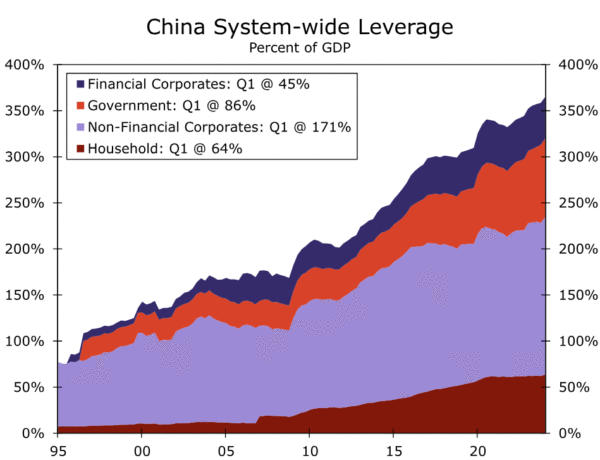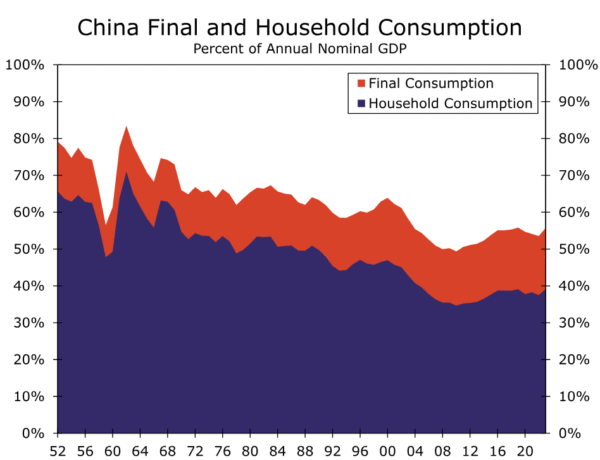Summary
High profile policy announcements from China have captured financial markets’ attention over the past few weeks. China’s central bank eased monetary policy, while the Ministry of Finance deployed fiscal resources to aid the property sector and local banks. However, with few fiscal resources deployed toward supporting broader domestic demand, we don’t think the growth impact of the latest stimulus announcements will be any different for China. We believe that utilizing the policy support playbook from the last fifteen years will not be enough to change China’s short or long-term economic trajectory, and that policy measures that are not aimed at generating consumer spending will ultimately fall short of authorities’ intentions. China’s economy, in our view, is still staring down at annual GDP growth in the 4.5% range for the next few years. We also expect the recent burst of market optimism around China to fade, and a range of systemically important emerging market nations could be at risk of sentiment swings. With China’s policy support announcements missing the mark, combined with a Federal Reserve taking a more gradual approach to easing, 2025 could be a year defined by significant emerging market currency depreciation.
The Time Has Come For China to Change
Chinese authorities have now hosted two highly publicized stimulus announcements over the past few weeks. The announcement in September was particularly focused on easing monetary policy, but also other actions designed to help China’s economy achieve the government’s 5% growth target. This past weekend, China’s Ministry of Finance (MoF) followed up September’s announcement with a stronger effort toward economic support. The latest policy support is more centered around fiscal stimulus. China’s Finance Minister communicated a willingness to take on more debt and expand government fiscal deficits (general and local), allowed for greater usage of local government bond issuance proceeds, dedicated support to China’s local real estate sector and offered additional support to local governments to recapitalize bank balance sheets. While details of MoF stimulus are still somewhat vague, Chinese authorities are once again adjusting policy settings in a more accommodative direction in an effort to support China’s economy. The shift to policy accommodation is notable. Essentially since the Global Financial Crisis in 2008-2009, Chinese authorities have attempted to balance supporting economic growth with reducing financial stability risks. This balance has been a challenge that has seen authorities at times dip into stimulus by allowing increased leverage, and at other times aim to deleverage by sacrificing economic growth. For the most part, authorities have leaned in favor of supporting activity, which has seen system-wide debt rise significantly over the past fifteen years (Figure 1). Following a brief period of striving for deleveraging post-pandemic, authorities are now clearly more committed to sparking growth than deleveraging China’s economy, again opening the tap to policy support, both monetary and fiscal. Historically, Chinese authorities flipping to stimulus has supported growth and led to China’s economy being one of the largest single contributors to global GDP growth.
However—and this is where our “This Time is Not Different” title comes into play—all the above mentioned policy support draws from a playbook that is outdated and no longer able to provide material long-lasting momentum to China’s economy. In our latest International Economic Outlook we dedicated specific commentary to China’s September policy actions with the takeaway being that we were underwhelmed. Gradual monetary easing combined with vague commitments to limited future fiscal stimulus was a policy communication that we believe missed the mark. We have similar takeaways from the latest MoF announcement. Fiscal stimulus, so far, is primarily aimed at China’s real estate sector and improving local bank balance sheets. While we acknowledge the local property sector and bank balance sheets need support, targeting fiscal resources solely toward these issues is merely a band-aid for China’s economy. In our view, consumer confidence is too weak to make this kind of fiscal support, by itself, impactful. Meaning, fiscal stimulus needs to be primarily deployed toward generating domestic demand and improving consumer sentiment (Figure 2). Any policy adjustments that do not include specific stimulus to spark domestic consumption in our view miss the mark and will ultimately not match authorities’ intentions. As of now, MoF fiscal stimulus has little dedicated toward reviving domestic demand. Cash handouts are slim, subsides slimmer, the social safety net shallow, and authorities have provided little to reverse deflationary pressures and create justification for households to deploy cash savings. President Xi and his closet advisors continue to push back on these types of support policies, consistently saying “welfarism policies” are not an appropriate policy response to subdued consumer activity. But with the old blueprint for economic success expired, China’s policy response to deteriorating conditions this time needs to be different to have a meaningful growth impact.
With our view that recent policy actions are insufficient, we are not adjusting our 2024 nor 2025 China GDP growth forecasts. We continue to believe China’s economy will grow just 4.6% this year and 4.3% next year, and will continue to decelerate over the medium term as imbalances persist. We also believe that the current rally in China’s local financial markets is overdone and a correction is likely to occur in the near future. Local equity indices have already started to unwind the latest gains, but going forward, unless policies aimed at domestic demand are announced and implemented in the coming weeks, we would expect benchmark indices to slip further and for sentiment toward the Chinese renminbi to soften. China plays an important role in the global economy as well as global financial markets, and if sentiment toward the second largest economy in the world turns more negative, we would expect spillovers to reach other parts of the world, particularly the emerging markets. In that sense, we updated and refreshed our “China Sensitivity” framework to get a sense of which developing nations could be most at risk of a reversal in sentiment toward China. To identify at-risk nations, our framework incorporates trade linkages between China and peer emerging market nations—both from an export and import perspective. Countries with an elevated dependency on demand from China, such as South Korea, Thailand and South Africa, can see their respective economies come under pressure, while nations still overly dependent on China from a supply chain perspective, such as South Korea, Thailand and Singapore, could be impacted if manufacturing and production out of China softens. Our framework also includes financial markets indicators, more specifically “betas”, to measure how sensitive peer nation benchmark equity indices and currencies are to moves in China’s local equity market and the renminbi. For example, if China’s Shanghai Composite equity index sells off 1%, equity indices of countries our framework identify as “highly sensitive” can experience a selloff greater than 1%. Same idea for a depreciation of the renminbi. A 1% depreciation in the renminbi could lead to a greater selloff for highly sensitive currencies, including but not limited to the South African rand, Chilean peso and Brazilian real.
Taking trade and financial market linkages in aggregate, our framework suggests South Korea, Thailand, South Africa, Chile and Peru are most sensitive, and in turn most at risk, to the reversal in sentiment that we believe will unfold. On the other hand, economies and financial markets in countries such as India and the Philippines may not be impacted as significantly by a selloff in China’s equity indices or depreciation pressures building on China’s currency that we expect. In these latter cases, trade linkages are modest, and while Indian equities may be overly sensitive to Chinese equities, other measures of sensitivity suggest India’s economy and the rupee may be relatively insulated from developments in China. As far as how we utilize this sensitivity analysis, in our October International Economic Outlook we will incorporate a softening in China sentiment into our emerging markets, and possibly broader currency forecasts. In that sense, while we already forecast most emerging market currencies to weaken in 2025, countries associated with elevated degrees of sensitivity toward the renminbi could see their respective currencies come under more pressure than we initially expected. Unless additional Chinese stimulus is offered, and that stimulus is more geared toward domestic demand, we plan on baking a China-induced depreciation into many of the highly and moderately sensitive currencies on top of what we already forecast. 2025 could be a year of significant stress in the emerging markets. We have already scaled back the amount of easing we expect from the Federal Reserve, which should lead to broad U.S. dollar strength and emerging market FX weakness. Tack on trouble in China, and emerging market currencies may be in for a rough ride next year.















